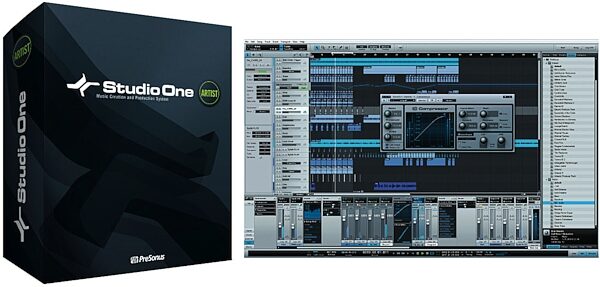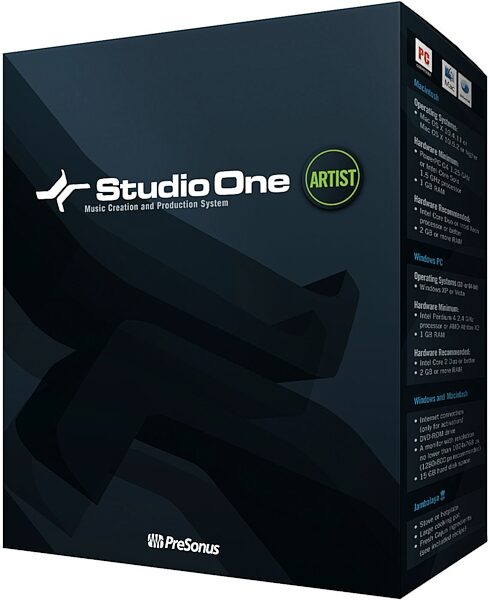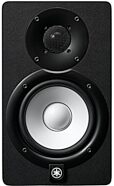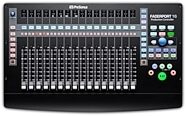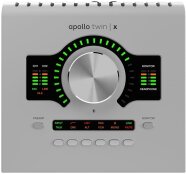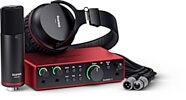PreSonus Studio One Artist Music Production Software (Mac and Windows)
No longer available at zZounds


zZounds Gear Experts Say...
Build your own wall of sound with this software's ability to record unlimited audio tracks. This version also includes a new feature for syncing audio and video.
Overview
Artists of all levels, from beginner to seasoned professional, will find Studio One a serious alternative to the intimidating, bloated offerings currently considered the standards. It's a groundbreaking music creation and production application for Mac OS X and Windows XP/Vista/7 that makes audio recording, MIDI sequencing, and audio mastering ridiculously simple right out of the box.
Studio One changes the rules of the game with fresh code, innovative drag-and-drop MIDI mapping and plug-in management, auto-configuration with PreSonus hardware, insanely good audio quality, unlimited tracks and plug-ins per track, and a powerful, inventive Start page.
And although Studio One Pro hit the scene just months ago we've already added even still more pro chops with Version 1.5. From tracking to mixing to mastering and distribution, it's the creative environment built for intuitive use, speed, and efficiency-and yet it's robust enough for the most complex productions. 70+ v1.5 enhancements but still uncluttered and simple to use.
Top Ten New Studio One v1.5 Features:
- Integrated Video Playback via Quicktime
- SoundCloud integration (www.soundcloud.com) for instant uploading of songs to web sites, FaceBook, etc. without exiting Studio One
- Key Command Editor -- Easily create custom key command maps
- 64-bit Vista/7 and Snow Leopard operation (Logic is only other DAW that does this)
- Improved Automation Editing with Draw Figures (Line, Parabola, Square, Triangle, Saw, Sine) and manipulate… read more with unique Transform tool
- Drag to Browser functionality -- The Browser is now a 'two-way street', drag inserts to store presets/fx chains, drag audio events to bounce files to a location, drag instrument parts to bounce midi files to a location
- New Plug-ins, Content, and existing Effect and Instrument Improvements
o Impact now has multiple velocity layers
o Presence now has Multi-FX Section
o New Scope and Level Meter plug-ins
o Pipeline has a unique integrated scope to calibrate signal path latency
o Automatable Bypass for insert effects
o Tons of new presets for built-in effects
o Over 2GB new content for all users
- Export Stems -- Easily bounce any combination of Audio/Instrument Tracks, Buses, or FX channels
- Editing Improvements across the board such as unlimited Undo History (even after you've saved!), Event position constrain when dragging between tracks, New Split at Cursor command, new musical functions, etc
- Support for Apple Loops (CAF files, OSX only) & REX file
Those who create sound for picture will be delighted with the new video features. You can now import any QuickTime video into a Song for playback and sync, with adjustable video playback size and time offset. Simply drag-and-drop the video from the Browser into the arrangement to import it and, optionally, simultaneously extract the audio from the video and place it on a new audio track. A new Follow Edit Position helps sync to specific video frames by adjusting the playback-cursor position based on the current edit position.
Browser drag-and-drop functionality has improved significantly. Drag an audio event to a location in the File Browser to instantly export a new audio file to that location. Drag an Instrument Part to the File Browser to export a MIDI clip to a specific location on your drive. Drag any insert effect or virtual instrument from the Device Rack to the Effects or Instruments Browser to store a preset for the effect or instrument; alternatively, drag to the File Browser to export the preset to a specific location on your drive.
You can now draw automation waveforms, and automation points are locked to selected events, so automation moves with the related events. A transform function lets you scale, stretch, and otherwise modify automation envelopes. An Undo history enables viewing and undoing all edits done since the file was opened, even if you have saved since then. A pitch-name editor is available in the drum layout, and you can save and load names from a pitch-name list.
Version 1.5 adds a new key-command editor with Search and Learn features for creating and modifying keyboard shortcuts. The search feature finds specific key commands and shows which functions they trigger and also finds specified functions and displays the key commands to which they are assigned.
Studio One now uses dynamic timestretching to change tempos within an event, rather than having to slice the event into separate events with different tempos. Constrain position when dragging events between tracks within a defined range, use a keyboard shortcut to fast-forward and rewind by measures, and accelerate scrolling while dragging with the new Turbo mode. When you select a region on a track, you can now extend the selection using Shift and the Up/Down arrow keys. When you select and remove a range in the Edit menu, the time in between regions will be deleted and the regions will snap together.
Album and Song Art can now be added to the Project and will be included in any exported Digital Release. A new menu item enables you to upload songs, art, and metadata to the SoundCloud Web service directly from Studio One.
Support for REX files also has been added. If you right-click a REX file in the Browser and select "Send to new SampleOne," all slices are imported into SampleOne, and a new Instrument Part is created. Alternatively, you can drag the whole REX file, or individual slices, into the arrangement.
Several changes have been made to the Native Effects plug-ins. The Pipeline plug-in has gained a scope that enables you to manually alter the offset (in samples) for latency compensation. The scope displays send and return signals on top of each other and shows you the difference in real time, enabling you to manually adjust delay compensation, which is much more accurate than the automatic delay compensation found in some DAWs. In addition, latency compensation has been enabled for effects on input channels, so if you put an effect on an input channel, the software will ensure that the recorded track and processed input remain aligned.
Plug-ins can now be bypassed, and this can be automated. A new Level Meter plug-in provides an extra-large peak/RMS display. The PreSonus Presence(TM) virtual instrument has been redesigned, upgraded to 96 voices, and enhanced with effects, including modulation effects, pan, delay, distortion, gate, reverb, and a 7-band graphic EQ with settings for Lead (center frequencies range from 50 Hz to 10 kHz) and Bass (100 Hz to 6.4 kHz). The Impact(TM) virtual instrument adds Velocity layers, an envelope Hold parameter, and a multimode low-pass, bandpass, or high-pass filter with 12 dB or 24 dB slope. To load effects to a specific output channel, just drag the effect onto a pad.
The Spectrum Meter plug-in and the spectrum meter on the Project page (in Studio One Pro) have gained average and peak-hold level indicators with variable time intervals for precise level analysis across the frequency spectrum. A new Scope plug-in provides in-depth oscilloscope functions for troubleshooting and measurement within Studio One, including three independent/overlaid channels with stereo and sidechain input selection and a mathematical operation channel (A-B, A-C, and B-C).
Version 1.5 also includes several MIDI enhancements. The file Browser has gained a MIDI preview player that sends the MIDI data to a selected Instrument Track for playback. The player displays the MIDI file's length in bars and the number of notes in the pattern. Previously, MIDI quantization only affected Note On messages; now note ends (Note Off) can be quantized, as well. The Gate plug-in now sends MIDI note messages--perfect for drum replacement. Furthermore, MIDI files can be expanded in the Browser, and individual tracks can be dragged into the arrangement.
The export features have been significantly improved, including the ability to export entire channels as stems, complete with buses, effects, and instrument returns. In addition, when you export adjacent regions (between markers), you can now create custom-length overlaps at the head and tail of each region so that you can crossfade between the exported files. This works sort of like a pre-roll and post-roll. Studio One creates a folder for each region with a name derived from the marker name.
ALL MEAT. NO FAT.
Studio One is a groundbreaking music-creation and production application for Mac OS X and Windows XP/Vista that makes audio recording, MIDI sequencing, and audio mastering ridiculously simple right out of the box, yet provides a wealth of professional features.
Fresh code, innovative drag-and-drop MIDI mapping and plug-in management, auto-configuration with PreSonus hardware, insanely good audio quality, unlimited tracks and plug-ins per track, and a powerful, inventive Start page that literally puts the whole project right in your hands are just a few of the compelling features that make Studio One the next generation in audio software. Far from just another music-production program, Studio One changes the rules of the game, giving you a complete, easy-to-use solution from raw tracks to finished master, while supporting the latest standards and technologies.
Studio One Artist
Studio One Artist is not a dumbed-down, "lite" version of Studio One Pro. Rather, it's just one version of the same creative recording and production platform--with unlimited track count and the same intuitive interface. Studio One Artist is bundled with all PreSonus FireStudio audio interfaces and is also available separately from authorized dealers.
Features
- Elegant single-window work environment
- Powerful drag-and-drop functionality
- Unlimited audio tracks, MIDI tracks, virtual instruments, buses, and FX channels
- Content browser with convenient sort options and preview player
- Automatic delay compensation
- Advanced automation
- 32-bit processing
- Easy-to-use sidechain routing
- Stunning virtual instruments
- User-friendly sampler
- Most intuitive MIDI-mapping system available
- Real-time audio timestretching and resampling
- K-System metering
- Compatible with any ASIO-, Windows Audio-, or Core Audio-compliant audio interface
- Works with key commands from Pro Tools, Cubase, and Logic.
- Native Effects(TM) 32-bit effects library with 20 dynamics processors, reverbs, modulations effects, amp simulators, etc.
# Four virtual instruments:
- Impact(TM) Sample Trigger Drum Instrument with 32 drum kits by Ueberschall(TM)
- Presence(TM) Sample Player Virtual Instrument with 200 sampled instruments by Digital Sound Factory(TM)
- SampleOne(TM) Sampler Virtual Instrument
- Mojito(TM) Analog-Modeling Subtractive Synthesizer
- Native Instruments(TM) Kore(TM) Player with 150 instruments
- Native Instruments(TM) Guitar Rig LE
- Toontrack(TM) EZDrummer Lite
- Nearly 1,400 drum loops (1.4 GB!) by Bandmate(TM) Loops
A VISION CREATED FROM EXPERIENCE
A fresh new DAW from a hardware company? Yes and no.
Yes, PreSonus has been creating high-quality digital audio interfaces for years. In the past, we bundled our interfaces with third-party DAWs. But we weren't entirely happy with any of the choices: the "pro" versions are so cluttered with features that are used by only a handful of people that it's difficult to access the tools used constantly, and the entry-level versions usually have severe limitations, including a limited number of tracks. So we decided to provide PreSonus customers with software that is powerful and easy to use, integrates tightly with our hardware, and works well with competing hardware that supports Core Audio or ASIO.
But, no, we didn't try to write a DAW programs ourselves! When developing our StudioLive 16.4.2 digital mixer, we needed a really simple but great-sounding recording application that would tightly integrate with it. We found great partners in Wolfgang Kundrus and Matthias Juwan of KristalLabs in Hamburg, Germany, who had previously worked on such Steinberg mainstays as Nuendo and Cubase. We were so impressed with their skills and products that we decided to team with them to simultaneously develop Capture, the StudioLive 16.4.2's software mate, and Studio One. Visit www.presonussoftware.com to meet this incredibly talented group of DAW veterans.
Our goal was clear and simple: Wipe the slate clean and apply decades of collective software and hardware experience to bring the DAW back to the musician and producer. After two years of coding and testing, Studio One Artist and Studio One Pro are the result.
High-End Audio Engine
Studio One is based on a cutting-edge audio engine that delivers unparalleled sound. Studio One Pro's 64-bit audio engine automatically switches between 32-bit and 64-bit floating-point processing on the fly (even with a 32-bit OS), ensuring the highest quality audio at all times. Studio One Artist's audio engine always operates in 32-bit mode.
Compatible and Easy to Configure
Studio One is compatible with any ASIO-, Windows Audio-, or CoreAudio-compliant audio interface, including, of course, the entire line of PreSonus interfaces. Studio One recognizes your PreSonus interface, and preprogrammed templates automatically create software inputs and assign them to the appropriate hardware inputs on your PreSonus interface. You don't have to configure your software to work with your hardware--Studio One does it for you!"
Studio One stores I/O configurations with each song, for each computer, and for each device driver. As a result, you can take a song to a friend's studio, use Studio One with their interface, and when you get back to your studio, Studio One will recall the original I/O configuration for the song, as if you never left. This works regardless of interface.
Innovative Start Page
A powerful tool that will appeal to professionals and hobbyists alike, the Start page allows you to access recent songs and projects, create new ones, configure external devices, and access tutorial information, demo songs, and a special PreSonus news feed. You can download updates and support materials directly from the Start page, without ever leaving Studio One.
Easy to Navigate
Unlike most music-production programs, a single, straightforward workspace allows you to track, edit, and mix in one easy-to-navigate window that you can access with a single click. Or if you wish, you can separate the Console and Arrange views and can even drag them to separate displays. A compact Console view allows you to mix while viewing the arrangement so you don't have to bounce back and forth between windows. You also can switch to a larger Console view--yet another way that Studio One helps you work quickly while giving you maximum flexibility.
The Arrange view employs a waveform display with user-selectable color-coding and sample-level zoom. The Arrange view shows you the big picture, while the Edit view shows you the up-close details; used together, they virtually eliminate the need to zoom in and out. The Console view contains faders, solos, mutes, pans, and other expected elements. It also includes extensive sidechaining capability.
Studio One's Browser provides instant access to effects, loops, instruments, and other key elements. You can preview any audio clip, and if the clip has tempo information encoded, it will play synced to the song tempo.
Powerful Drag-and-Drop Features
Here's where it gets really interesting: Studio One's powerful drag-and-drop function allows you to drag an audio clip, effect, or a virtual instrument from the Browser directly onto a track in the Arrange or Console view. Time stretching enables Studio One to automatically match tempo-encoded audio clips with Song tempo. You can copy an effect or a whole chain of effects--including settings--by simply dragging to a new track in the Console view. These are just a few of the many ways that Studio One's Browser and drag-and-drop implementation allow you to work quickly, without scrolling through pages of menus. It's a lot more fun too! No other music-production program even comes close.
Awesome Plug-Ins
Studio One ships with a generous library of PreSonus's proprietary Native Effects Suite plug-ins, which include a wide variety of built-in effects, such as compressors, EQs, distortion, delay effects, amp modeling, modulation effects, and reverbs. These are brand-new plug-ins that process audio with 64-bit floating-point double precision in Studio One Pro and with 32-bit floating-point single precision in Studio One Artist. This is truly state-of-the-art technology. Studio One also utilizes automatic latency (processing delay) compensation, which keeps tracks in sync regardless of plug-in processing.
Four new PreSonus virtual instruments are also bundled with both versions of Studio One, including SampleOne, a virtual sampler that offers the fastest sample mapping available.
Furthermore, Studio One Pro supports ReWire and the VST and AU plug-in formats, including the new VST 3 plug-in specification (also with automatic latency compensation), so you are ready to use the newest plug-ins as they are released.
Easy, Intuitive MIDI Mapping
When it comes to MIDI mapping, Studio One changes the rules yet again. Of course, you can record MIDI parts and then tweak them in a piano-roll editor. But the real fun starts with Control Link, the most intuitive MIDI-mapping system available. Simply move the hardware and software controls to be linked and click the Link button for instant mapping. In Global mode, hardware and software controls maintain a one-to-one relationship, so a hardware control is linked directly to one software control for the entire program. In Focus mode, control maps only apply to a particular plug-in, so you can make different control maps for each plug-in, and the Focus map is stored with the plug-in, giving you no-sweat, context-sensitive MIDI mapping. This works with all parameters of any VST or AU plug-in. At last, a music-production application that makes controller mapping as easy and flexible as it always should have been!
Integrated Mastering Suite (Studio One Pro)
The Project page (Studio One Pro only) is a complete mastering solution that is fully integrated with the rest of the program. The Project page includes all the necessary tools to create a production-quality master, including effects, crossfades, volume envelopes, and meters. You can make disc images, burn Red Book CDs, and create digital-release albums, complete with metadata. In addition, Studio One Pro creates an intelligent link when songs are placed in a Project for mastering, automatically updating any changes to the original tracks or subsequent mixes. From basic tracking to multiple-release mastering, Studio One Pro is the complete solution. read less
Studio One changes the rules of the game with fresh code, innovative drag-and-drop MIDI mapping and plug-in management, auto-configuration with PreSonus hardware, insanely good audio quality, unlimited tracks and plug-ins per track, and a powerful, inventive Start page.
And although Studio One Pro hit the scene just months ago we've already added even still more pro chops with Version 1.5. From tracking to mixing to mastering and distribution, it's the creative environment built for intuitive use, speed, and efficiency-and yet it's robust enough for the most complex productions. 70+ v1.5 enhancements but still uncluttered and simple to use.
Top Ten New Studio One v1.5 Features:
- Integrated Video Playback via Quicktime
- SoundCloud integration (www.soundcloud.com) for instant uploading of songs to web sites, FaceBook, etc. without exiting Studio One
- Key Command Editor -- Easily create custom key command maps
- 64-bit Vista/7 and Snow Leopard operation (Logic is only other DAW that does this)
- Improved Automation Editing with Draw Figures (Line, Parabola, Square, Triangle, Saw, Sine) and manipulate… read more with unique Transform tool
- Drag to Browser functionality -- The Browser is now a 'two-way street', drag inserts to store presets/fx chains, drag audio events to bounce files to a location, drag instrument parts to bounce midi files to a location
- New Plug-ins, Content, and existing Effect and Instrument Improvements
o Impact now has multiple velocity layers
o Presence now has Multi-FX Section
o New Scope and Level Meter plug-ins
o Pipeline has a unique integrated scope to calibrate signal path latency
o Automatable Bypass for insert effects
o Tons of new presets for built-in effects
o Over 2GB new content for all users
- Export Stems -- Easily bounce any combination of Audio/Instrument Tracks, Buses, or FX channels
- Editing Improvements across the board such as unlimited Undo History (even after you've saved!), Event position constrain when dragging between tracks, New Split at Cursor command, new musical functions, etc
- Support for Apple Loops (CAF files, OSX only) & REX file
Those who create sound for picture will be delighted with the new video features. You can now import any QuickTime video into a Song for playback and sync, with adjustable video playback size and time offset. Simply drag-and-drop the video from the Browser into the arrangement to import it and, optionally, simultaneously extract the audio from the video and place it on a new audio track. A new Follow Edit Position helps sync to specific video frames by adjusting the playback-cursor position based on the current edit position.
Browser drag-and-drop functionality has improved significantly. Drag an audio event to a location in the File Browser to instantly export a new audio file to that location. Drag an Instrument Part to the File Browser to export a MIDI clip to a specific location on your drive. Drag any insert effect or virtual instrument from the Device Rack to the Effects or Instruments Browser to store a preset for the effect or instrument; alternatively, drag to the File Browser to export the preset to a specific location on your drive.
You can now draw automation waveforms, and automation points are locked to selected events, so automation moves with the related events. A transform function lets you scale, stretch, and otherwise modify automation envelopes. An Undo history enables viewing and undoing all edits done since the file was opened, even if you have saved since then. A pitch-name editor is available in the drum layout, and you can save and load names from a pitch-name list.
Version 1.5 adds a new key-command editor with Search and Learn features for creating and modifying keyboard shortcuts. The search feature finds specific key commands and shows which functions they trigger and also finds specified functions and displays the key commands to which they are assigned.
Studio One now uses dynamic timestretching to change tempos within an event, rather than having to slice the event into separate events with different tempos. Constrain position when dragging events between tracks within a defined range, use a keyboard shortcut to fast-forward and rewind by measures, and accelerate scrolling while dragging with the new Turbo mode. When you select a region on a track, you can now extend the selection using Shift and the Up/Down arrow keys. When you select and remove a range in the Edit menu, the time in between regions will be deleted and the regions will snap together.
Album and Song Art can now be added to the Project and will be included in any exported Digital Release. A new menu item enables you to upload songs, art, and metadata to the SoundCloud Web service directly from Studio One.
Support for REX files also has been added. If you right-click a REX file in the Browser and select "Send to new SampleOne," all slices are imported into SampleOne, and a new Instrument Part is created. Alternatively, you can drag the whole REX file, or individual slices, into the arrangement.
Several changes have been made to the Native Effects plug-ins. The Pipeline plug-in has gained a scope that enables you to manually alter the offset (in samples) for latency compensation. The scope displays send and return signals on top of each other and shows you the difference in real time, enabling you to manually adjust delay compensation, which is much more accurate than the automatic delay compensation found in some DAWs. In addition, latency compensation has been enabled for effects on input channels, so if you put an effect on an input channel, the software will ensure that the recorded track and processed input remain aligned.
Plug-ins can now be bypassed, and this can be automated. A new Level Meter plug-in provides an extra-large peak/RMS display. The PreSonus Presence(TM) virtual instrument has been redesigned, upgraded to 96 voices, and enhanced with effects, including modulation effects, pan, delay, distortion, gate, reverb, and a 7-band graphic EQ with settings for Lead (center frequencies range from 50 Hz to 10 kHz) and Bass (100 Hz to 6.4 kHz). The Impact(TM) virtual instrument adds Velocity layers, an envelope Hold parameter, and a multimode low-pass, bandpass, or high-pass filter with 12 dB or 24 dB slope. To load effects to a specific output channel, just drag the effect onto a pad.
The Spectrum Meter plug-in and the spectrum meter on the Project page (in Studio One Pro) have gained average and peak-hold level indicators with variable time intervals for precise level analysis across the frequency spectrum. A new Scope plug-in provides in-depth oscilloscope functions for troubleshooting and measurement within Studio One, including three independent/overlaid channels with stereo and sidechain input selection and a mathematical operation channel (A-B, A-C, and B-C).
Version 1.5 also includes several MIDI enhancements. The file Browser has gained a MIDI preview player that sends the MIDI data to a selected Instrument Track for playback. The player displays the MIDI file's length in bars and the number of notes in the pattern. Previously, MIDI quantization only affected Note On messages; now note ends (Note Off) can be quantized, as well. The Gate plug-in now sends MIDI note messages--perfect for drum replacement. Furthermore, MIDI files can be expanded in the Browser, and individual tracks can be dragged into the arrangement.
The export features have been significantly improved, including the ability to export entire channels as stems, complete with buses, effects, and instrument returns. In addition, when you export adjacent regions (between markers), you can now create custom-length overlaps at the head and tail of each region so that you can crossfade between the exported files. This works sort of like a pre-roll and post-roll. Studio One creates a folder for each region with a name derived from the marker name.
ALL MEAT. NO FAT.
Studio One is a groundbreaking music-creation and production application for Mac OS X and Windows XP/Vista that makes audio recording, MIDI sequencing, and audio mastering ridiculously simple right out of the box, yet provides a wealth of professional features.
Fresh code, innovative drag-and-drop MIDI mapping and plug-in management, auto-configuration with PreSonus hardware, insanely good audio quality, unlimited tracks and plug-ins per track, and a powerful, inventive Start page that literally puts the whole project right in your hands are just a few of the compelling features that make Studio One the next generation in audio software. Far from just another music-production program, Studio One changes the rules of the game, giving you a complete, easy-to-use solution from raw tracks to finished master, while supporting the latest standards and technologies.
Studio One Artist
Studio One Artist is not a dumbed-down, "lite" version of Studio One Pro. Rather, it's just one version of the same creative recording and production platform--with unlimited track count and the same intuitive interface. Studio One Artist is bundled with all PreSonus FireStudio audio interfaces and is also available separately from authorized dealers.
Features
- Elegant single-window work environment
- Powerful drag-and-drop functionality
- Unlimited audio tracks, MIDI tracks, virtual instruments, buses, and FX channels
- Content browser with convenient sort options and preview player
- Automatic delay compensation
- Advanced automation
- 32-bit processing
- Easy-to-use sidechain routing
- Stunning virtual instruments
- User-friendly sampler
- Most intuitive MIDI-mapping system available
- Real-time audio timestretching and resampling
- K-System metering
- Compatible with any ASIO-, Windows Audio-, or Core Audio-compliant audio interface
- Works with key commands from Pro Tools, Cubase, and Logic.
- Native Effects(TM) 32-bit effects library with 20 dynamics processors, reverbs, modulations effects, amp simulators, etc.
# Four virtual instruments:
- Impact(TM) Sample Trigger Drum Instrument with 32 drum kits by Ueberschall(TM)
- Presence(TM) Sample Player Virtual Instrument with 200 sampled instruments by Digital Sound Factory(TM)
- SampleOne(TM) Sampler Virtual Instrument
- Mojito(TM) Analog-Modeling Subtractive Synthesizer
- Native Instruments(TM) Kore(TM) Player with 150 instruments
- Native Instruments(TM) Guitar Rig LE
- Toontrack(TM) EZDrummer Lite
- Nearly 1,400 drum loops (1.4 GB!) by Bandmate(TM) Loops
A VISION CREATED FROM EXPERIENCE
A fresh new DAW from a hardware company? Yes and no.
Yes, PreSonus has been creating high-quality digital audio interfaces for years. In the past, we bundled our interfaces with third-party DAWs. But we weren't entirely happy with any of the choices: the "pro" versions are so cluttered with features that are used by only a handful of people that it's difficult to access the tools used constantly, and the entry-level versions usually have severe limitations, including a limited number of tracks. So we decided to provide PreSonus customers with software that is powerful and easy to use, integrates tightly with our hardware, and works well with competing hardware that supports Core Audio or ASIO.
But, no, we didn't try to write a DAW programs ourselves! When developing our StudioLive 16.4.2 digital mixer, we needed a really simple but great-sounding recording application that would tightly integrate with it. We found great partners in Wolfgang Kundrus and Matthias Juwan of KristalLabs in Hamburg, Germany, who had previously worked on such Steinberg mainstays as Nuendo and Cubase. We were so impressed with their skills and products that we decided to team with them to simultaneously develop Capture, the StudioLive 16.4.2's software mate, and Studio One. Visit www.presonussoftware.com to meet this incredibly talented group of DAW veterans.
Our goal was clear and simple: Wipe the slate clean and apply decades of collective software and hardware experience to bring the DAW back to the musician and producer. After two years of coding and testing, Studio One Artist and Studio One Pro are the result.
High-End Audio Engine
Studio One is based on a cutting-edge audio engine that delivers unparalleled sound. Studio One Pro's 64-bit audio engine automatically switches between 32-bit and 64-bit floating-point processing on the fly (even with a 32-bit OS), ensuring the highest quality audio at all times. Studio One Artist's audio engine always operates in 32-bit mode.
Compatible and Easy to Configure
Studio One is compatible with any ASIO-, Windows Audio-, or CoreAudio-compliant audio interface, including, of course, the entire line of PreSonus interfaces. Studio One recognizes your PreSonus interface, and preprogrammed templates automatically create software inputs and assign them to the appropriate hardware inputs on your PreSonus interface. You don't have to configure your software to work with your hardware--Studio One does it for you!"
Studio One stores I/O configurations with each song, for each computer, and for each device driver. As a result, you can take a song to a friend's studio, use Studio One with their interface, and when you get back to your studio, Studio One will recall the original I/O configuration for the song, as if you never left. This works regardless of interface.
Innovative Start Page
A powerful tool that will appeal to professionals and hobbyists alike, the Start page allows you to access recent songs and projects, create new ones, configure external devices, and access tutorial information, demo songs, and a special PreSonus news feed. You can download updates and support materials directly from the Start page, without ever leaving Studio One.
Easy to Navigate
Unlike most music-production programs, a single, straightforward workspace allows you to track, edit, and mix in one easy-to-navigate window that you can access with a single click. Or if you wish, you can separate the Console and Arrange views and can even drag them to separate displays. A compact Console view allows you to mix while viewing the arrangement so you don't have to bounce back and forth between windows. You also can switch to a larger Console view--yet another way that Studio One helps you work quickly while giving you maximum flexibility.
The Arrange view employs a waveform display with user-selectable color-coding and sample-level zoom. The Arrange view shows you the big picture, while the Edit view shows you the up-close details; used together, they virtually eliminate the need to zoom in and out. The Console view contains faders, solos, mutes, pans, and other expected elements. It also includes extensive sidechaining capability.
Studio One's Browser provides instant access to effects, loops, instruments, and other key elements. You can preview any audio clip, and if the clip has tempo information encoded, it will play synced to the song tempo.
Powerful Drag-and-Drop Features
Here's where it gets really interesting: Studio One's powerful drag-and-drop function allows you to drag an audio clip, effect, or a virtual instrument from the Browser directly onto a track in the Arrange or Console view. Time stretching enables Studio One to automatically match tempo-encoded audio clips with Song tempo. You can copy an effect or a whole chain of effects--including settings--by simply dragging to a new track in the Console view. These are just a few of the many ways that Studio One's Browser and drag-and-drop implementation allow you to work quickly, without scrolling through pages of menus. It's a lot more fun too! No other music-production program even comes close.
Awesome Plug-Ins
Studio One ships with a generous library of PreSonus's proprietary Native Effects Suite plug-ins, which include a wide variety of built-in effects, such as compressors, EQs, distortion, delay effects, amp modeling, modulation effects, and reverbs. These are brand-new plug-ins that process audio with 64-bit floating-point double precision in Studio One Pro and with 32-bit floating-point single precision in Studio One Artist. This is truly state-of-the-art technology. Studio One also utilizes automatic latency (processing delay) compensation, which keeps tracks in sync regardless of plug-in processing.
Four new PreSonus virtual instruments are also bundled with both versions of Studio One, including SampleOne, a virtual sampler that offers the fastest sample mapping available.
Furthermore, Studio One Pro supports ReWire and the VST and AU plug-in formats, including the new VST 3 plug-in specification (also with automatic latency compensation), so you are ready to use the newest plug-ins as they are released.
Easy, Intuitive MIDI Mapping
When it comes to MIDI mapping, Studio One changes the rules yet again. Of course, you can record MIDI parts and then tweak them in a piano-roll editor. But the real fun starts with Control Link, the most intuitive MIDI-mapping system available. Simply move the hardware and software controls to be linked and click the Link button for instant mapping. In Global mode, hardware and software controls maintain a one-to-one relationship, so a hardware control is linked directly to one software control for the entire program. In Focus mode, control maps only apply to a particular plug-in, so you can make different control maps for each plug-in, and the Focus map is stored with the plug-in, giving you no-sweat, context-sensitive MIDI mapping. This works with all parameters of any VST or AU plug-in. At last, a music-production application that makes controller mapping as easy and flexible as it always should have been!
Integrated Mastering Suite (Studio One Pro)
The Project page (Studio One Pro only) is a complete mastering solution that is fully integrated with the rest of the program. The Project page includes all the necessary tools to create a production-quality master, including effects, crossfades, volume envelopes, and meters. You can make disc images, burn Red Book CDs, and create digital-release albums, complete with metadata. In addition, Studio One Pro creates an intelligent link when songs are placed in a Project for mastering, automatically updating any changes to the original tracks or subsequent mixes. From basic tracking to multiple-release mastering, Studio One Pro is the complete solution. read less
Specs
System Requirements
Macintosh:
Operating Systems: Mac OS X 10.4.11 or Mac OS X 10.5.2 or higher
Hardware:
- Minimum:
-- PowerPC G4 1.25 GHz or Intel Core Solo 1.5 GHz processor
-- 1 GB RAM
- Recommended:
-- PowerPC G5 or better or Intel Core Duo or Intel Xeon processor or better
-- 2 GB or more RAM
Windows PC:
Operating Systems: Windows XP, Windows Vista, and Windows 7
Hardware:
- Minimum:
-- Intel Pentium 4 1.6 GHz processor or AMD Athlon 64 (Turion)
-- 1 GB RAM
- Recommended:
-- Intel Pentium 4 2.8 GHz EM64T or better or AMD Athlon 64 3000+ or better
-- 2 GB or more RAM
Windows and Macintosh Systems:
Internet connection
DVD-ROM drive
A monitor resolution no lower than 1024x768 pixels
Macintosh:
Operating Systems: Mac OS X 10.4.11 or Mac OS X 10.5.2 or higher
Hardware:
- Minimum:
-- PowerPC G4 1.25 GHz or Intel Core Solo 1.5 GHz processor
-- 1 GB RAM
- Recommended:
-- PowerPC G5 or better or Intel Core Duo or Intel Xeon processor or better
-- 2 GB or more RAM
Windows PC:
Operating Systems: Windows XP, Windows Vista, and Windows 7
Hardware:
- Minimum:
-- Intel Pentium 4 1.6 GHz processor or AMD Athlon 64 (Turion)
-- 1 GB RAM
- Recommended:
-- Intel Pentium 4 2.8 GHz EM64T or better or AMD Athlon 64 3000+ or better
-- 2 GB or more RAM
Windows and Macintosh Systems:
Internet connection
DVD-ROM drive
A monitor resolution no lower than 1024x768 pixels
Documents and Manuals
For support or warranty questions, please contact the manufacturer:
Phone: 225-216-7887
Web: https://support.presonus.com
Phone: 225-216-7887
Web: https://support.presonus.com
No longer available at zZounds
In most cases, a product is unavailable because it has been discontinued by the manufacturer
This is a carousel with product cards. Use the previous and next buttons to navigate.
